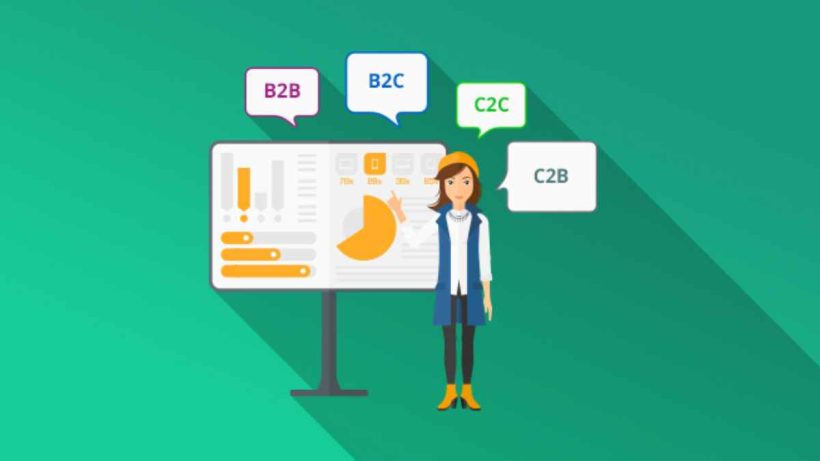There are six types of eCommerce businesses (not to be confused with eCommerce tools for marketing), depending on whether the buyer or seller is one of these three parties: a business, a consumer, or the government. Let’s see what each of these does and how they work.
1. Business-to-Business (B2B)
There are two types of selling products and services in terms of how large the scale of the sale is. You can sell wholesale and retail. When you sell wholesale you sell a large number of your merchandise to a shop owner to sell in retail, meaning in small numbers, to the end consumer. So that means a business that has produced or bought the goods in large amounts is selling to another business that is going to sell them again but to the customer, so that makes the transaction business to business, and the platform a B2B.
Another type of B2B is when an eCommerce tool company like a marketing or CRO sells its services to a B2C e-commerce website, or a big e-store platform rents out its digital space to B2C websites. Here are these three types of B2B platforms explained in more detail, and among the wide range of B2B platforms, these have the most effectiveness and popularity:
1.1. E-Commerce Marketing Platforms
When an online store, which is a B2C website itself, is built, the owner needs to devise a marketing strategy of how to drive traffic to the website so they have actual shoppers to buy their products or services, so they need a variety of marketing platforms, one of the most effective and popular ones being an influencer marketing platform like Ainfluencer.
1.2. Conversion Rate Optimization Tools
When you have either used an open source website builder like WordPress, or have commissioned website building B2Bs to design you a B2C e-store, and you have used marketing tools, and you are getting many users on your site looking to buy something, you need to use the services of website analytics and optimization tools to track the behavior of your potential customers and see how you can convert more of them into actual customers. These are called conversion rate optimization (CRO) tools, one of the most effective ones being Watchthemlive, with a must-have service called a web site heatmap.
1.3. Space-For-Hire E-Commerce Platform
There are two ways you can go when you want to open an online store, you can have your own website built and have an amount of marketing, like SEO, content marketing, and influencer marketing done, to get steady traffic to your website. Another more popular and more business-savvy way is to choose a highly-optimized B2B e-commerce platform like Shopify, and use their space to set up your shop. They have designed a platform to host thousands of stores with their separate space, which rids you of the marketing, website design, security issues, and many other hassles. Many B2C platforms owe their success to B2B platforms like Shopify.
2. Business-to-Consumer (B2C)
After buying bulk from the produce, the retailer sells the products to customers over time, so the transaction is between a business and a consumer, and the platform is called B2C. There are many world-famous B2C platforms like Amazon.
3. Consumer-To-Consumer (C2C)
There are times when a consumer has bought an item from a business, and for a variety of reasons, having used it or kept it new, decides to sell it. Now before the days of technology that would either be to used-good flippers, or through garage sales, but after the age of the internet hit, websites like eBay and Craigslist came about, where the consumer who wants to sell the item can directly find a new consumer, without going through a third party middleman. So, the transaction is between a consumer and another consumer, making the platform C2C.
4. Consumer-To-Business (C2B)
There are cases where the citizens who are typically the consumer of products from businesses, have a skill set in a niche area and sell their product or services to a business, for example, freelancers like website designers, photographers, and content writers. So, that makes the transaction between a consumer and a business, but this time the consumer is the seller and the business is the buyer. It’s known as C2B, Google AdSense and Shutterstock are good examples.
5. Business-To-Administration (B2A)
When a company sells its goods or services to a governmental organization, the transaction happens between a business and the administration, giving it the name B2A. Many website builders and optimizers that help the government present the public with software platforms to provide access to government services or organizations and get a whole slew of administrative paperwork done fall under this category. Platforms for filing for the draft, pensions, or disability payments are good examples of solutions B2A platforms build. Accela is one such business.
6. Consumer-to-Administration (C2A)
The websites that the B2A websites design for the government get used by the public, known as the consumer in the business lingo, to get connected to a government sector and get administrative tasks done are considered C2A. It could be filing for tax returns, mandatory payments like child support, or national vaccination campaigns. On these types of platforms, consumers are dealing with administration, which gives it the name C2A. EFTPS, Electronic Federal Tax Payment System is a good example.
Laila Azzahra is a professional writer and blogger that loves to write about technology, business, entertainment, science, and health.
